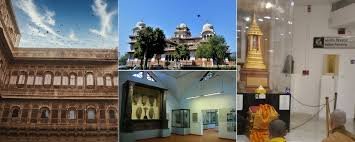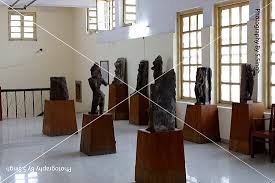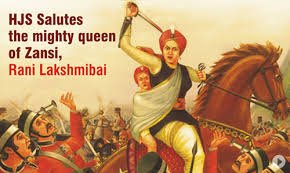Rani Durgavati Museum in Jabalpur, Madhya Pradesh: A Historical Treasure
Introduction to the Rani Durgavati Museum
The Rani Durgavati Museum, located in the heart of Jabalpur, Madhya Pradesh, is a well-known historical site and a cultural hub that attracts visitors from across the country. Named after Rani Durgavati, the valiant queen of the Gond dynasty, this museum showcases a rich collection of sculptures, artifacts, and relics from ancient Indian history, with a particular focus on the Gond period. It serves as a window into the region’s history and cultural heritage, making it a must-visit for history enthusiasts and students preparing for government exams.
Historical Significance of Rani Durgavati
Rani Durgavati was a legendary figure who ruled over the Gondwana kingdom in the mid-16th century. She is celebrated for her courage and valor, especially during her resistance against the Mughal emperor Akbar’s forces. The museum not only pays homage to her bravery but also preserves the cultural and artistic legacy of the region. It features sculptures from different eras, including the Gupta and Kalachuri periods, which help visitors understand the historical importance of Madhya Pradesh.
Museum Collection and Exhibits
The museum is home to an extensive collection of artifacts, ranging from sculptures, weapons, and paintings to ancient manuscripts. Many of these items date back to the 10th and 11th centuries, reflecting the historical richness of the region. The exhibits include stone carvings from Hindu and Jain temples, tribal artifacts, and relics from the Mughal period, giving visitors a comprehensive view of the cultural evolution of Central India.
Educational and Cultural Importance
For students preparing for exams like IAS, PSCS, and other government positions, understanding the importance of historical sites like the Rani Durgavati Museum can be crucial. The museum provides insight into the architectural and artistic styles of ancient India, helping aspirants develop a deeper understanding of the cultural and historical context of the region. Such knowledge can be useful when answering questions related to Indian history, culture, and heritage in competitive exams.

Why This News Is Important
Relevance for Exam Aspirants
This news about the Rani Durgavati Museum is particularly important for students preparing for government exams. Jabalpur, being famous for this museum, is a key historical city in Madhya Pradesh. Questions related to Indian historical figures, important cultural landmarks, and their significance frequently appear in competitive exams like UPSC, SSC, and state-level civil services exams. Understanding the contribution of Rani Durgavati to India’s history, along with the historical richness showcased by this museum, can give aspirants an edge in exams.
Cultural Heritage and Preservation
The museum also highlights the importance of preserving India’s cultural heritage. In recent years, efforts have been made to digitize artifacts and improve the museum’s infrastructure. Understanding these preservation efforts can also help candidates when discussing India’s steps towards safeguarding its history in exam essays and interviews.
Historical Context: Rani Durgavati and Jabalpur
The historical context of the Rani Durgavati Museum is rooted in the story of Rani Durgavati, who reigned over the Gond kingdom from 1550 to 1564. She became a symbol of resistance when she chose to fight against the Mughal emperor Akbar’s expansion into her kingdom. Despite her defeat in battle, Rani Durgavati is remembered as a fearless warrior who stood up for her people. Her legacy is celebrated in Jabalpur, where this museum, along with various memorials, commemorates her contribution to Indian history.
Jabalpur itself has long been an important city in Indian history, serving as a center for governance during different dynasties, including the Gond, Maratha, and British periods. The Rani Durgavati Museum preserves much of this historical richness, showcasing artifacts that tell the story of the city and the region over centuries.
Key Takeaways from “Rani Durgavati Museum in Jabalpur”
| S. No | Key Takeaway |
|---|---|
| 1 | The Rani Durgavati Museum is located in Jabalpur, Madhya Pradesh, and is named after the 16th-century warrior queen, Rani Durgavati. |
| 2 | The museum houses an extensive collection of sculptures, artifacts, and relics from various periods, including the Gupta and Kalachuri eras. |
| 3 | Rani Durgavati is known for her brave resistance against the Mughal emperor Akbar’s forces. |
| 4 | The museum serves as a cultural and historical hub, highlighting the region’s artistic and architectural legacy. |
| 5 | Understanding the significance of historical figures like Rani Durgavati is crucial for students preparing for government exams. |
Important FAQs for Students from this News
1. What is the significance of the Rani Durgavati Museum?
The Rani Durgavati Museum is significant for preserving the cultural heritage of Madhya Pradesh. It showcases a rich collection of artifacts from various historical periods, particularly highlighting the legacy of Rani Durgavati, a valiant queen who fought against Mughal invasions.
2. Where is the Rani Durgavati Museum located?
The museum is located in Jabalpur, Madhya Pradesh, which is known for its historical importance and connection to the Gond dynasty.
3. What kind of artifacts can be found in the museum?
The museum features a variety of artifacts, including sculptures, ancient manuscripts, weapons, and relics from the Gupta and Kalachuri periods, reflecting the artistic evolution of Central India.
4. How can understanding the museum’s significance benefit students preparing for government exams?
Knowledge of historical sites like the Rani Durgavati Museum can help students in competitive exams by providing insights into Indian history, culture, and significant historical figures, which are common topics in various exams.
5. Are there any recent developments related to the Rani Durgavati Museum?
Yes, there have been efforts to digitize artifacts and improve the museum’s infrastructure to enhance visitor experience and preserve its collections.
Some Important Current Affairs Links

















